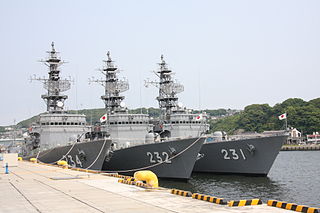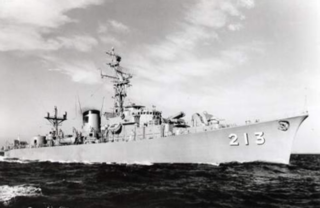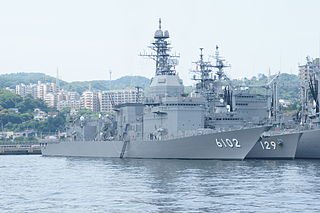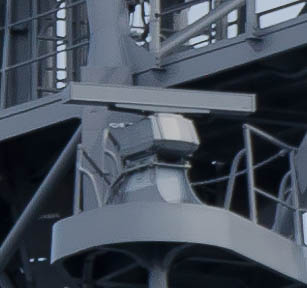
The Murasame-class destroyer is a class of destroyers, serving with the Japan Maritime Self-Defense Force (JMSDF). This is the first class of the second-generation general-purpose destroyers of the JMSDF.

The Asagiri-class destroyer is a class of destroyer, serving with the Japan Maritime Self-Defense Force (JMSDF). It was the second class of first generation general-purpose destroyers of the JMSDF.

JDS Akebono was a destroyer escort of the Japanese Maritime Self-Defense Force. Akebono was one of the first indigenous Japanese warships to be built following World War II. Akebono was laid down in 1954 as a steam turbine powered "B type" ASW escort, the only ship of its class, for comparison with two similar diesel powered ships, the Ikazuchi-class destroyer escorts. Akebono entered service in 1956 and remained in use until 1976.

The Abukuma-class destroyer escort is the general-purpose destroyer escort of the Japan Maritime Self-Defense Force. It is the successor of the earlier Yūbari class.
Four Japanese destroyers have been named Akebono:
Four Japanese destroyers have been named Ikazuchi:

Type 81 Fire Control System (FCS-2) is a Japanese shipboard gun and missile fire-control system. This series of systems has been installed on destroyers of the Japan Maritime Self-Defense Force built between FY1977 and FY2001 to control medium-caliber guns and Sea Sparrow missiles, including ESSM.

FCS-3 is an integrated naval weapons system developed by the Japanese Defense Ministry for the Japan Maritime Self-Defense Force.

JDS Ikazuchi (DE-202) is the lead ship of Ikazuchi-class destroyer escort of Japan Maritime Self-Defense Force.

JDS Inazuma (DE-203) is the second ship of the Ikazuchi-class destroyer escorts of the Japan Maritime Self-Defense Force (JMSDF).

JDS Kitakami (DE-213) is the third ship of Ikazuchi-class destroyer escort of Japan Maritime Self-Defense Force.

The Asahi-class destroyer escort was a class of destroyer escorts of Japanese Maritime Self-Defense Force. Two ships were lent from the Cannon-class by the US Navy and in commissioned from 1955 until 1975.

JS Asuka (ASE-6102) is an experimental ship of the Japan Maritime Self-Defense Force. The vessel was constructed by Sumitomo Heavy Industries of Tokyo, Japan and was launched on 21 June 1994. Asuka was commissioned on 22 March 1995 and since then has conducted performance confirmation tests for integrated navigation systems.

The Asakaze-class destroyer is a class of destroyers of the Japan Maritime Self-Defense Force. Two ships of the Gleaves class were lent by the United States Navy and were in commission from 1954 until 1969.

OPS-14 is a two-dimensional radar manufactured by Mitsubishi Electric. It is mainly mounted on the Maritime Self-Defense Force's self-defense ship as an anti-aircraft search radar. Variations include OPS-14B and OPS-14C.

OPS-11 is a two-dimensional radar manufactured by Mitsubishi Electric. It is installed as an anti-aircraft search radar on the Maritime Self-Defense Force's escort ship, and it will be the first model originally developed by Japan after World War II for this purpose. Variations include OPS-11B and OPS-11C.

OPS-20 is a two-dimensional radar manufactured by Japan Radio. It is compatible with the Global Maritime Distress and Safety System (GMDSS) and installed as an anti-water search radar on the Maritime Self-Defense Force's escort ship. Variations include OPS-20B, OPS-20C and OPS-20E.

OPS-28 is a Pulse-Doppler radar manufactured by Japan Radio. It is installed as a low-altitude warning / anti-water search radar mainly on the Maritime Self-Defense Force's escort ship. Variations include OPS-28-1, OPS-28B, OPS-28C, OPS-28D, OPS-28E and OPS-28F.

AN/SPS-6 is a two-dimensional radar manufactured by Bendix and Westinghouse Electric. It was used by the US Navy as a first-generation air-search radar after World War II, and was widely exported to allies. In addition, the improved AN/SPS-12 is the derivative types developed in other countries.
























